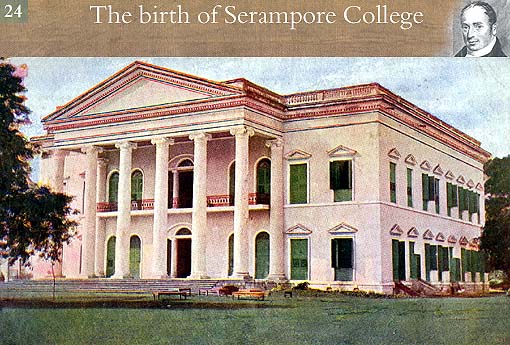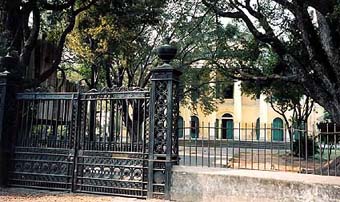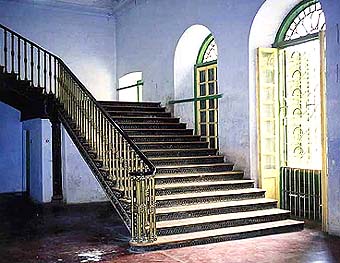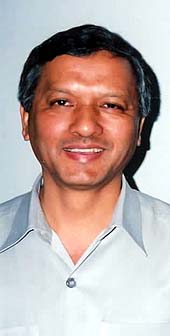

An old BMS postcard of Serampore College. Reproduced by kind permission of BMS World Mission (formerly the Baptist Missionary Society). The state of isolation in which Carey and his colleagues now found themselves did not produce any relaxation of labour. For several years they had been desirous of establishing an institution in which a higher, more complete education should be given to native students, more especially those of Christian parentage, and in which native preachers and schoolmasters should be efficiently trained up. They now determined to concentrate their exertions on the formation of a college. The times appeared favourable as the effect of Lord Hastings liberal views were felt through every vein of society, and associations for the improvement of the natives were springing up in every direction.
On 15th July, 1818, they issued the prospectus for a 'College for the instruction for the Asiatic, Christian, and other youth, in Eastern literature and European science.' It was drawn up by Joshua Marshman.
It was proposed to impart a thorough knowledge of Sanskrit so the students may be able to understand the tenets and principles of Hinduism. On the same principle instruction was to be given in Arabic, the language of Mohammedanism. The students were likewise to be thoroughly grounded in European science and knowledge through books in their own language, and explained in lectures. But English was by no means to be excluded from study and it was intended that, after they had completed his Sanskrit studies, a select number should be taught the English language. The college was likewise to train teachers in the science of instruction and managing schools. One of the chief objects was to prepare textbooks in Bengali to form the material for education in schools. But it was to be considered pre-eminently a divinity school, where Christian youths, of personal piety and aptitude for the work of an evangelist, should go through a complete course of instruction in Christian theology. It was to be open to youths from all parts of India without distinction of caste or creed. A library was to be formed, to include, in addition to works of classical and European literature, every manuscript of any value, Sanskrit or vernacular, which could be obtained in the country.
An edifice was to be erected suited to the objects of the institution. The government of the college was to be vested in the Governor of Serampore, for the time being, and the 3 senior missionaries.
The expense of the establishment was calculated at 1,960 rupees a month, which was considered sufficient to provide for 2 European professors, at 250 rupees, and a classical English tutor, at 200 rupees a month. The pundits and native teachers were estimated at 450 rupees, the expense of 150 students at 750 rupees a month. and 60 rupees were allotted for prizes monthly. The missionaries were desirous of raising a sum, after providing for the expenses of the ground, the building, and the library, that should form a fund for the permanent support of the college. They offered to subscribe £2,500 from their own resources and asked the public to make such additions to it as to place the institution on a solid basis.
During 1817 the Serampore missionaries had purchased land to the east of the premises and considerable additions were made till it extended to more than 5 acres. This was by far the most eligible plot of ground in Serampore. It lay in the eastern quarter of the town, apart from the hum of the population, and stretched along the bank of the river directly opposite the Governor-General's park at Barrackpore. It was long debated whether it would not be advisable to remove all the missionary establishments to this spot. The chief ground for rejecting this proposal was the injury caused by so open a manifestation of discord. It was therefore decided to appropriate them to the college buildings, and the ground plan and elevation of a noble edifice, for the accommodation of professors, teachers and 200 students, together with the requisite public rooms, was prepared by the best architectural skill in the country.
In August 1819, the missionaries issued the first report on the preliminary arrangements for the administration of students and the regulation of the classes. The report was submitted to Lord Hastings who gave his qualified approval. The queries raised were accepted by the missionaries and the plan modified. The present edifice, with its classical Ionic portico, is considered one of the noblest in India.
Later, in 1821, the Governor of Serampore called on the missionaries with a letter from the new King of Denmark. He assured the missionaries of the great interest he felt in the College, which he desired to take under his patronage, and of the progress and success of which he requested to be informed from time to time. As a token of his approbation of their labours, he bestowed a gold medal on each of the senior missionaries. They repectfully solicited permission to decline an honour unsuited to their position. The medal of merit was substituted, and the King likewise presented them with a more substantial token of his kindness. He transferred to them a large house and grounds in Serampore, in a very eligible situation, adjoining the premises Marshman had recently purchased. It was valued at £1,000 and the rent was to be perpetually applied to the support of the College.
The progress in organising the college between 1820 and 1821 was necessarily slow. Everything had to be created at a time when the Society declined its co-operation. In the report of the year 1821 they state that the number of pupils in daily attendance was 45. They could not effect the interior arrangements of the institution until their hands were strengthened by the return of Ward with the professor who was to accompany him.
An episcopal college was being built in Calcutta by Bishop Middleton in the Gothic style. The missionaries did not consider this north European style to be suited to the tropical climate, as ample ventilation is the paramount objective of every building in the East. They preferred the Grecian style, and a noble specimen was erected in the 10 acres of grounds. It was built under the superintendence of Major Wickerdie, the Second Member of the Council of Serampore, and the main building was completed in 1822.
This main building, intended for the public rooms, was 130 feet in length, and 120 in depth. The hall on the ground floor, supported on arches, and terminated at the south by a bow, was 95 feet in length, 66 in breadth, and 20 in height. It was originally intended for the library, but is now occupied by the classes. The hall above, of the same dimensions, and 26 feet in height, was supported by 2 rows of Ionic columns; it was intended for the annual examinations. Of the 12 side rooms above and below, 8 were of spacious dimensions, 27 feet by 35 feet. The portico which fronted the river was composed of 6 columns, more than 4 feet in diameter at the base. The stair-case was 90 feet in length, 27 in width, and 47 in height, with 2 staircases of cast-iron, of large size and elegant form, prepared at Birmingham. The spacious grounds were surrounded with iron railing, and the front entrance was adorned with a noble gate, likewise cast at Birmingham.



The scale on which it was proposed to establish the college corresponded with the the breadth of all the other enterprises of the Serampore missionaries, - the mission, the translations, and the schools. They proposed to augment their donation from £2,500 to £8,000, and to make a vigorous effort to erect the buildings from their own funds. The expense eventually grew to £15,000, and it had 11 trustees, 7 besides themselves.
The Serampore missionaries were the first who maintained that a college was an indispensable appendage to an Indian mission, they were followed by the Episopalians, the Independents, and the two sections of the Presbyterian church, each of which were supported by the assistance of public contributions.
To become a 'Friend of Serampore' go to www.friendsofserampore.org.uk. The site is run by Edward and Rosemary Williams, formerly of Serampore, who publish regular newsletters. Support the College with your interest, donations and prayers. A class of theology students at Serampore College in 2003, with the student's accommodation in the background. The Principal, Dr. Lalchungnunga is on the extreme right.

Dr. Lalchungnunga, Principal of Serampore College and successor to William Carey and John Mack. Photos courtesy of the Rev. Peter Shepherd, minister of Broadway Baptist Church, Derby and successor to the Rev. J. D. G. Pike, minister of Brook Street Baptist Chapel, Derby; founder member and the first Secretary of the General Baptist Missionary Society, whose first missionaries sailed to India with William Ward in May, 1821.